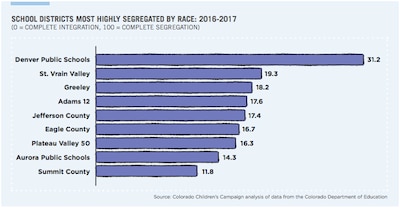Denver schools are more racially segregated today than they were a decade ago, even with the district’s share of white students growing over that time.
That finding, from the KIDS COUNT report released by the Colorado Children’s Campaign today, highlights a problem that has dogged officials in Denver and across the nation for decades and will soon draw the attention of a new Denver Public Schools committee charged with addressing school diversity in the gentrifying city.
Denver Superintendent Tom Boasberg said he doesn’t necessarily agree that Denver schools are more segregated today, citing some city schools such as Skinner Middle School that are better integrated today than 10 years ago. Still, he acknowledged that race- and income-based segregation is a major challenge for the district.
“We have very significant housing separation and segregation in this city as we see in so many communities across the country … so then you also see that in our schools,” he said.
Data provided by the Colorado Children’s Campaign — but not included in the 2017 KIDS COUNT report — shows a slight downward trend in Denver Public Schools “segregation index” since the measure’s high-water mark in 2014-15. Even so, that index today is higher than it’s been in the district for most of the last 13 years and higher than in any other Colorado district.
Despite a surge in the city’s population, enrollment growth is slowing in DPS and low-income families are being pushed out. This year, about three-quarters of students districtwide are students of color and two-thirds are low-income — both lower figures than five years ago.
In Colorado, segregated schools aren’t unique to Denver. Suburban and rural districts, including St. Vrain Valley, Eagle County and Greeley, also have highly segregated schools, according to the KIDS COUNT report.
Highly segregated schools, where poor children of color are often concentrated, typically lack the financial resources and more experienced teachers that can be found in less segregated schools. The report also cites recent landmark research from Stanford University that shows segregation is a significant predictor of achievement gaps — differences in achievement levels associated with students’ race or socioeconomic status.

Boasberg said the district’s new “Citywide Strengthening Neighborhoods” committee, which will have about 30 members and kick off in June, will discuss possible changes to the district’s school boundary, enrollment and choice systems “to drive greater integration in our schools.”
He acknowledged that race, class and segregation can be highly sensitive topics.
“Will there be concerns on all sides? Yes,” he said. “Will there be any one set of proposals that will make everyone happy? No.”
Still, he noted that he hears both parents and students say they want to see Denver’s diversity reflected in their schools.
Plus, he said, “There’s lots of research that says integrated schools are win-win for all kids, for all economic backgrounds and races.”
Lisa Flores, a school board member who represents the rapidly gentrifying northwest Denver, said she hopes the committee will focus not just on crafting policy but also examining the public perceptions that accompany ideas like desegregation and integration.
“We have in many ways evolved as a community and in many ways face some of the cultural challenges that we faced 40 or 50 years ago,” she said. “I’m hoping for some short-term wins and I’m aware that this is long haul work.”
The district has made some efforts to increase integration, including the use of enrollment zones. Students living in such zones are guaranteed enrollment at one of several schools within the zone’s boundaries but not necessarily the one closest to their home. The idea is to pull students from a larger, more diverse area, thereby lessening the effects of highly segregated neighborhoods. So far, the zones have had mixed success.
Seven of the district’s 11 enrollment zones focus on middle schools and two on high schools. Two others, one encompassing the upscale Stapleton neighborhood, and a smaller one in far southeast Denver, target elementary schools.
Still, segregation at the elementary level can be stark. For example, the KIDS COUNT report highlights two schools with vastly different demographics: Valverde and Steele elementaries.
At Valverde, which has the lowest of five quality ratings, 95 percent of students are children of color and 96 percent qualify for free or discounted meals, a proxy for poverty. Two miles away in the pricey Washington Park neighborhood is Steele, which has the second highest quality rating. There, just 17 percent of students are children of color and 6 percent qualify for free or discounted meals.
But evening out such imbalances is a tricky proposition given the fraught history of integration efforts. In Denver, court-ordered busing in the 1970s sparked massive white flight to neighboring suburbs and more recently, enrollment zones have stirred worry among some parents. Contentious battles over integration are in full swing elsewhere, too, including in New York City where wealthy white parents have relentlessly fought school boundary changes that would lead to integration.
Despite the potential for acrimony, Flores draws optimism from her own experience as a Denver student during the era of court-ordered busing.
Her white, affluent classmates “were children of progressive parents who wanted to walk the talk around integration,” she said. “You will still find those parents today that share the value of socioeconomic and racial integration and want their children to experience that type of learning environment.”

